Kennedy's Flexible Response and Military Operations in the Korean War
VerifiedAdded on 2023/06/12
|6
|1501
|50
Essay
AI Summary
This essay explores two significant aspects of American military history: President John F. Kennedy's 'flexible response' strategy and the Korean War. It contrasts Kennedy's approach with Eisenhower's 'New Look' policy, highlighting the impact of flexible response on the US military and NATO. The essay then delves into the Korean War, detailing major military operations from June to December 1950, examining key events that showcase the US as a superpower. It also identifies major leaders involved in US military operations and discusses military spending trends during this period. The essay concludes by emphasizing the military strengths of both the USA and its adversaries, China and the Soviet Union, during this era.
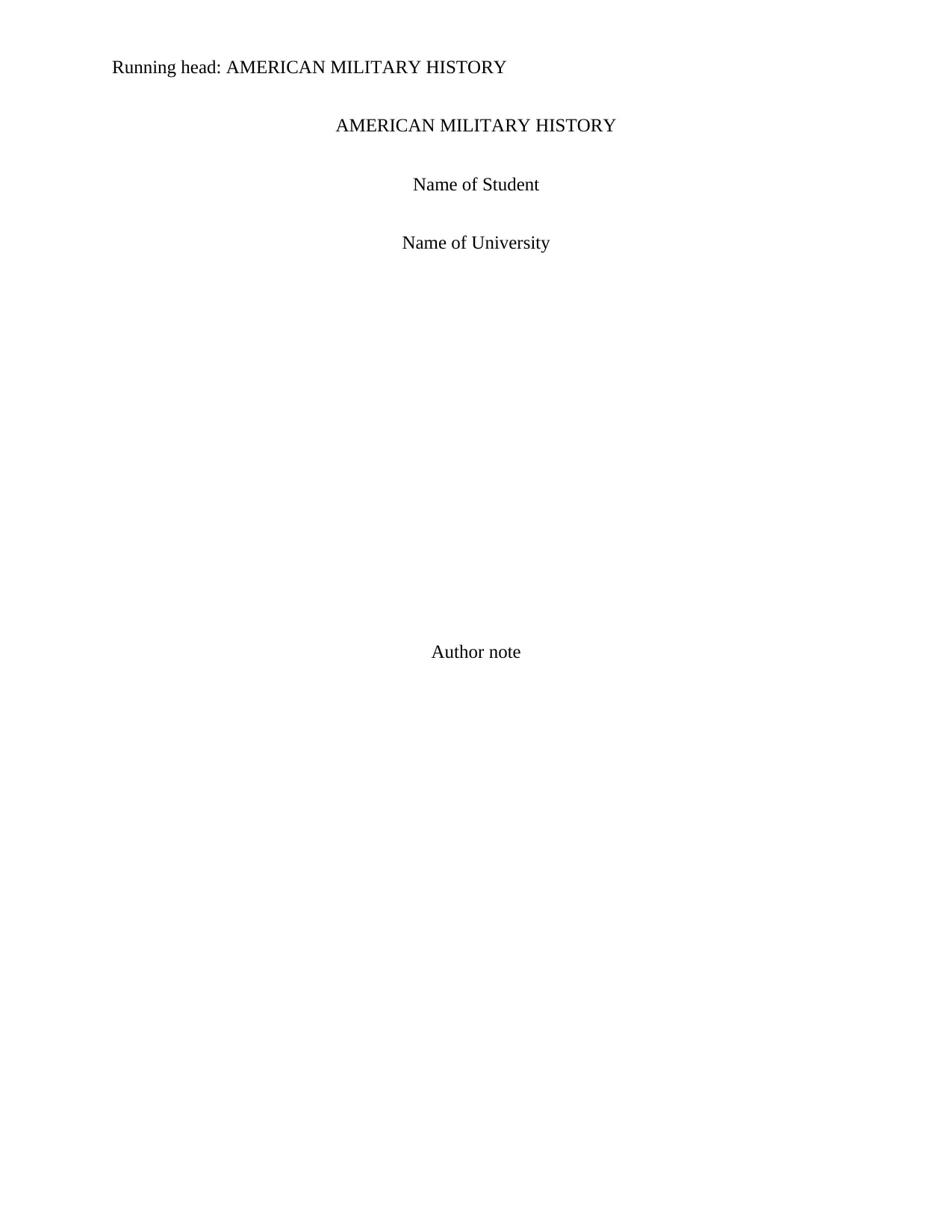
Running head: AMERICAN MILITARY HISTORY
AMERICAN MILITARY HISTORY
Name of Student
Name of University
Author note
AMERICAN MILITARY HISTORY
Name of Student
Name of University
Author note
Paraphrase This Document
Need a fresh take? Get an instant paraphrase of this document with our AI Paraphraser
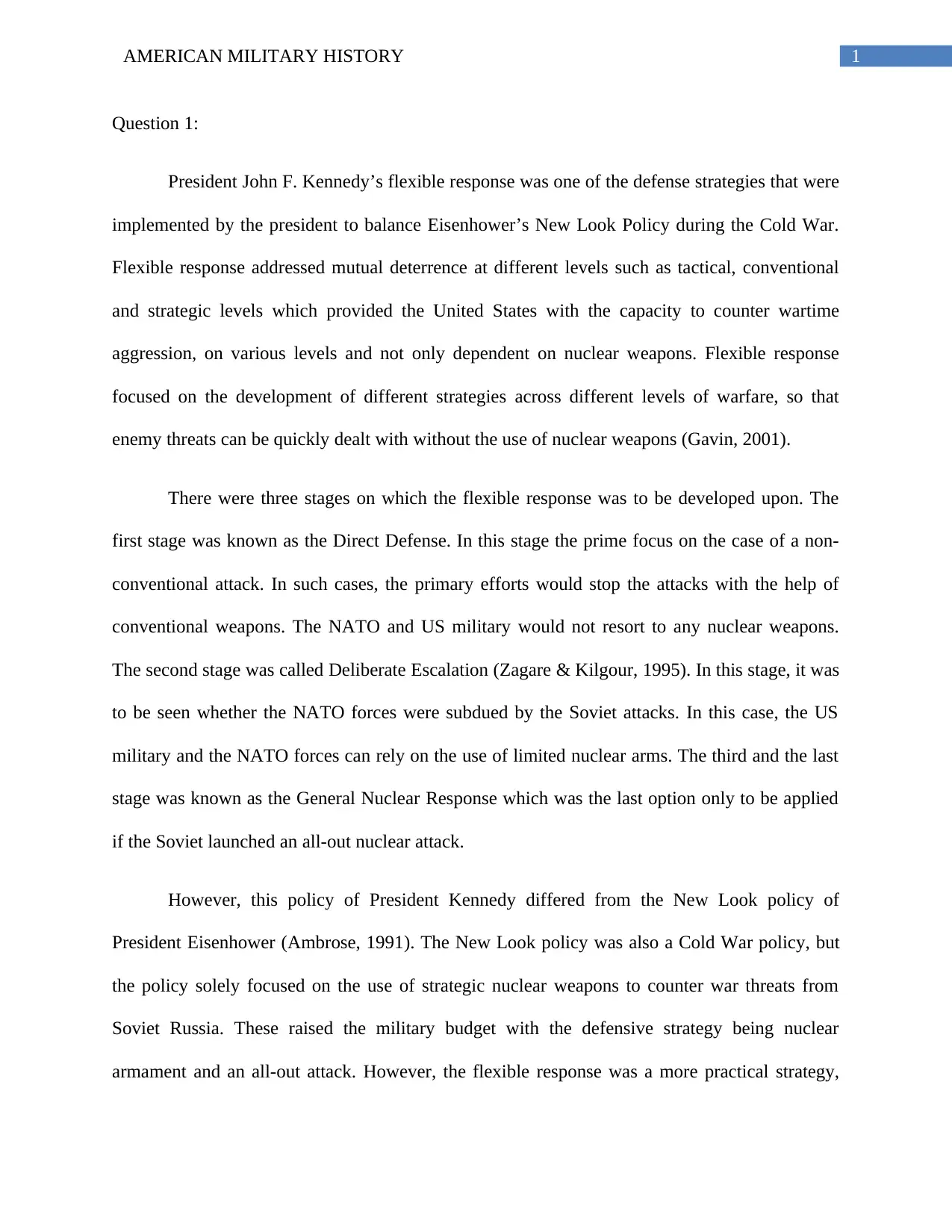
1AMERICAN MILITARY HISTORY
Question 1:
President John F. Kennedy’s flexible response was one of the defense strategies that were
implemented by the president to balance Eisenhower’s New Look Policy during the Cold War.
Flexible response addressed mutual deterrence at different levels such as tactical, conventional
and strategic levels which provided the United States with the capacity to counter wartime
aggression, on various levels and not only dependent on nuclear weapons. Flexible response
focused on the development of different strategies across different levels of warfare, so that
enemy threats can be quickly dealt with without the use of nuclear weapons (Gavin, 2001).
There were three stages on which the flexible response was to be developed upon. The
first stage was known as the Direct Defense. In this stage the prime focus on the case of a non-
conventional attack. In such cases, the primary efforts would stop the attacks with the help of
conventional weapons. The NATO and US military would not resort to any nuclear weapons.
The second stage was called Deliberate Escalation (Zagare & Kilgour, 1995). In this stage, it was
to be seen whether the NATO forces were subdued by the Soviet attacks. In this case, the US
military and the NATO forces can rely on the use of limited nuclear arms. The third and the last
stage was known as the General Nuclear Response which was the last option only to be applied
if the Soviet launched an all-out nuclear attack.
However, this policy of President Kennedy differed from the New Look policy of
President Eisenhower (Ambrose, 1991). The New Look policy was also a Cold War policy, but
the policy solely focused on the use of strategic nuclear weapons to counter war threats from
Soviet Russia. These raised the military budget with the defensive strategy being nuclear
armament and an all-out attack. However, the flexible response was a more practical strategy,
Question 1:
President John F. Kennedy’s flexible response was one of the defense strategies that were
implemented by the president to balance Eisenhower’s New Look Policy during the Cold War.
Flexible response addressed mutual deterrence at different levels such as tactical, conventional
and strategic levels which provided the United States with the capacity to counter wartime
aggression, on various levels and not only dependent on nuclear weapons. Flexible response
focused on the development of different strategies across different levels of warfare, so that
enemy threats can be quickly dealt with without the use of nuclear weapons (Gavin, 2001).
There were three stages on which the flexible response was to be developed upon. The
first stage was known as the Direct Defense. In this stage the prime focus on the case of a non-
conventional attack. In such cases, the primary efforts would stop the attacks with the help of
conventional weapons. The NATO and US military would not resort to any nuclear weapons.
The second stage was called Deliberate Escalation (Zagare & Kilgour, 1995). In this stage, it was
to be seen whether the NATO forces were subdued by the Soviet attacks. In this case, the US
military and the NATO forces can rely on the use of limited nuclear arms. The third and the last
stage was known as the General Nuclear Response which was the last option only to be applied
if the Soviet launched an all-out nuclear attack.
However, this policy of President Kennedy differed from the New Look policy of
President Eisenhower (Ambrose, 1991). The New Look policy was also a Cold War policy, but
the policy solely focused on the use of strategic nuclear weapons to counter war threats from
Soviet Russia. These raised the military budget with the defensive strategy being nuclear
armament and an all-out attack. However, the flexible response was a more practical strategy,
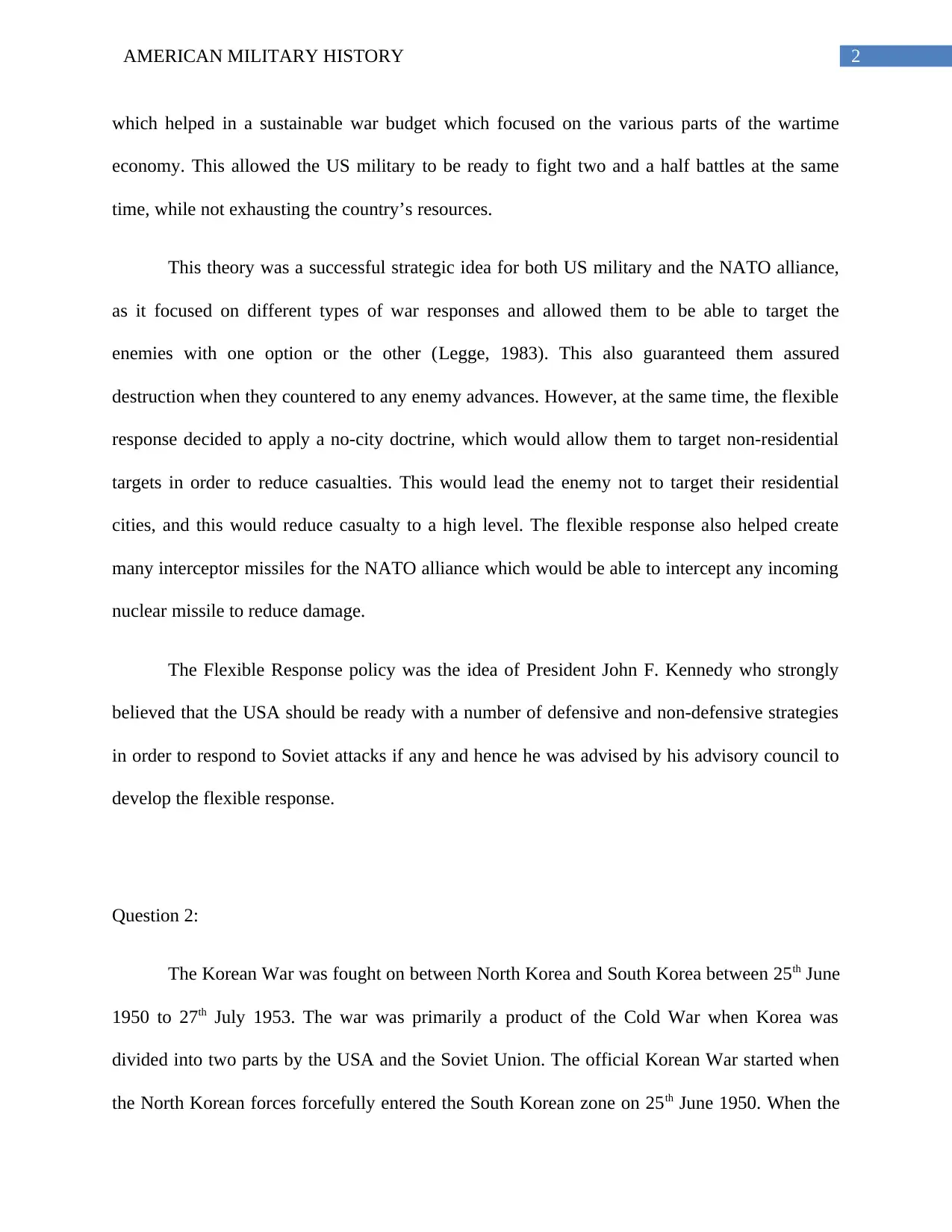
2AMERICAN MILITARY HISTORY
which helped in a sustainable war budget which focused on the various parts of the wartime
economy. This allowed the US military to be ready to fight two and a half battles at the same
time, while not exhausting the country’s resources.
This theory was a successful strategic idea for both US military and the NATO alliance,
as it focused on different types of war responses and allowed them to be able to target the
enemies with one option or the other (Legge, 1983). This also guaranteed them assured
destruction when they countered to any enemy advances. However, at the same time, the flexible
response decided to apply a no-city doctrine, which would allow them to target non-residential
targets in order to reduce casualties. This would lead the enemy not to target their residential
cities, and this would reduce casualty to a high level. The flexible response also helped create
many interceptor missiles for the NATO alliance which would be able to intercept any incoming
nuclear missile to reduce damage.
The Flexible Response policy was the idea of President John F. Kennedy who strongly
believed that the USA should be ready with a number of defensive and non-defensive strategies
in order to respond to Soviet attacks if any and hence he was advised by his advisory council to
develop the flexible response.
Question 2:
The Korean War was fought on between North Korea and South Korea between 25th June
1950 to 27th July 1953. The war was primarily a product of the Cold War when Korea was
divided into two parts by the USA and the Soviet Union. The official Korean War started when
the North Korean forces forcefully entered the South Korean zone on 25th June 1950. When the
which helped in a sustainable war budget which focused on the various parts of the wartime
economy. This allowed the US military to be ready to fight two and a half battles at the same
time, while not exhausting the country’s resources.
This theory was a successful strategic idea for both US military and the NATO alliance,
as it focused on different types of war responses and allowed them to be able to target the
enemies with one option or the other (Legge, 1983). This also guaranteed them assured
destruction when they countered to any enemy advances. However, at the same time, the flexible
response decided to apply a no-city doctrine, which would allow them to target non-residential
targets in order to reduce casualties. This would lead the enemy not to target their residential
cities, and this would reduce casualty to a high level. The flexible response also helped create
many interceptor missiles for the NATO alliance which would be able to intercept any incoming
nuclear missile to reduce damage.
The Flexible Response policy was the idea of President John F. Kennedy who strongly
believed that the USA should be ready with a number of defensive and non-defensive strategies
in order to respond to Soviet attacks if any and hence he was advised by his advisory council to
develop the flexible response.
Question 2:
The Korean War was fought on between North Korea and South Korea between 25th June
1950 to 27th July 1953. The war was primarily a product of the Cold War when Korea was
divided into two parts by the USA and the Soviet Union. The official Korean War started when
the North Korean forces forcefully entered the South Korean zone on 25th June 1950. When the
⊘ This is a preview!⊘
Do you want full access?
Subscribe today to unlock all pages.

Trusted by 1+ million students worldwide
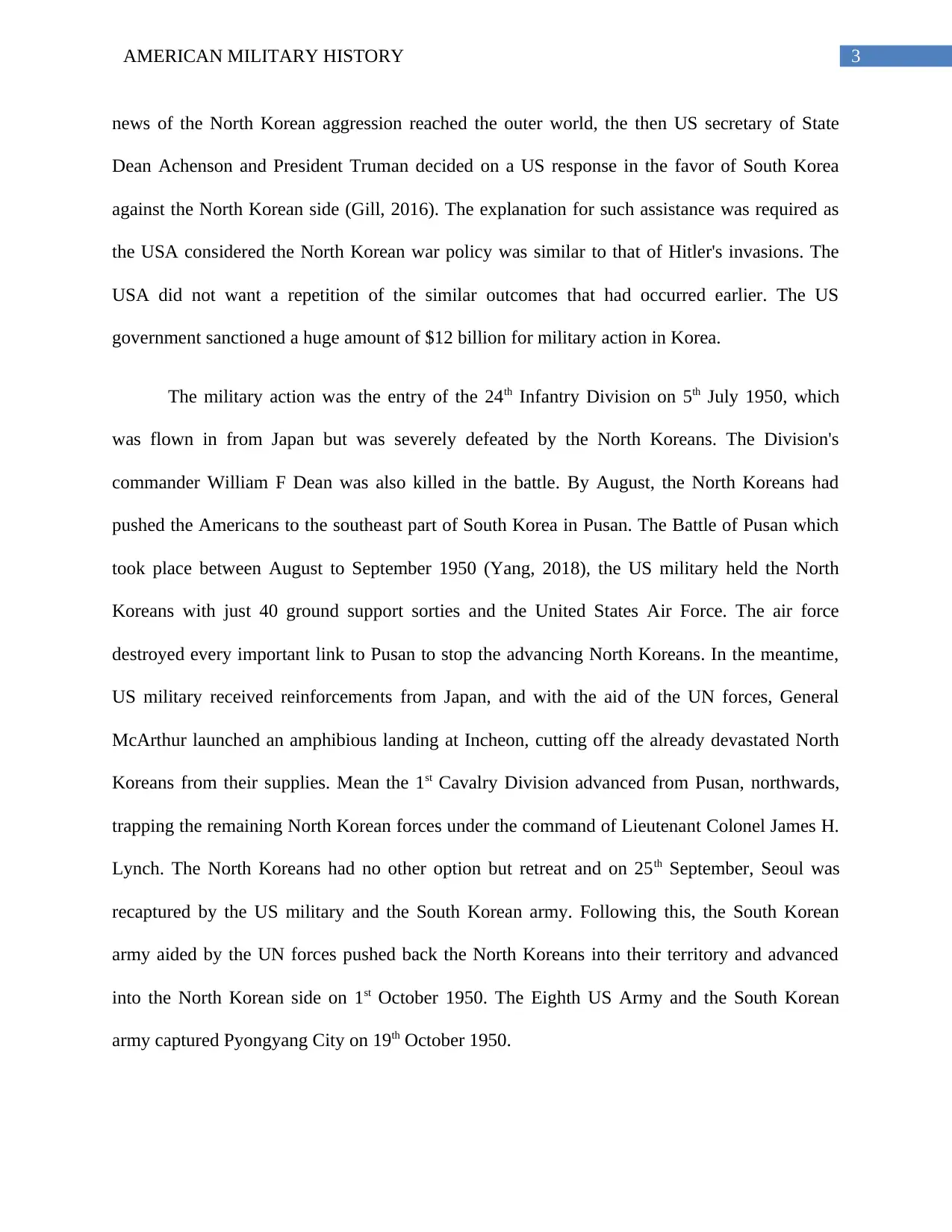
3AMERICAN MILITARY HISTORY
news of the North Korean aggression reached the outer world, the then US secretary of State
Dean Achenson and President Truman decided on a US response in the favor of South Korea
against the North Korean side (Gill, 2016). The explanation for such assistance was required as
the USA considered the North Korean war policy was similar to that of Hitler's invasions. The
USA did not want a repetition of the similar outcomes that had occurred earlier. The US
government sanctioned a huge amount of $12 billion for military action in Korea.
The military action was the entry of the 24th Infantry Division on 5th July 1950, which
was flown in from Japan but was severely defeated by the North Koreans. The Division's
commander William F Dean was also killed in the battle. By August, the North Koreans had
pushed the Americans to the southeast part of South Korea in Pusan. The Battle of Pusan which
took place between August to September 1950 (Yang, 2018), the US military held the North
Koreans with just 40 ground support sorties and the United States Air Force. The air force
destroyed every important link to Pusan to stop the advancing North Koreans. In the meantime,
US military received reinforcements from Japan, and with the aid of the UN forces, General
McArthur launched an amphibious landing at Incheon, cutting off the already devastated North
Koreans from their supplies. Mean the 1st Cavalry Division advanced from Pusan, northwards,
trapping the remaining North Korean forces under the command of Lieutenant Colonel James H.
Lynch. The North Koreans had no other option but retreat and on 25th September, Seoul was
recaptured by the US military and the South Korean army. Following this, the South Korean
army aided by the UN forces pushed back the North Koreans into their territory and advanced
into the North Korean side on 1st October 1950. The Eighth US Army and the South Korean
army captured Pyongyang City on 19th October 1950.
news of the North Korean aggression reached the outer world, the then US secretary of State
Dean Achenson and President Truman decided on a US response in the favor of South Korea
against the North Korean side (Gill, 2016). The explanation for such assistance was required as
the USA considered the North Korean war policy was similar to that of Hitler's invasions. The
USA did not want a repetition of the similar outcomes that had occurred earlier. The US
government sanctioned a huge amount of $12 billion for military action in Korea.
The military action was the entry of the 24th Infantry Division on 5th July 1950, which
was flown in from Japan but was severely defeated by the North Koreans. The Division's
commander William F Dean was also killed in the battle. By August, the North Koreans had
pushed the Americans to the southeast part of South Korea in Pusan. The Battle of Pusan which
took place between August to September 1950 (Yang, 2018), the US military held the North
Koreans with just 40 ground support sorties and the United States Air Force. The air force
destroyed every important link to Pusan to stop the advancing North Koreans. In the meantime,
US military received reinforcements from Japan, and with the aid of the UN forces, General
McArthur launched an amphibious landing at Incheon, cutting off the already devastated North
Koreans from their supplies. Mean the 1st Cavalry Division advanced from Pusan, northwards,
trapping the remaining North Korean forces under the command of Lieutenant Colonel James H.
Lynch. The North Koreans had no other option but retreat and on 25th September, Seoul was
recaptured by the US military and the South Korean army. Following this, the South Korean
army aided by the UN forces pushed back the North Koreans into their territory and advanced
into the North Korean side on 1st October 1950. The Eighth US Army and the South Korean
army captured Pyongyang City on 19th October 1950.
Paraphrase This Document
Need a fresh take? Get an instant paraphrase of this document with our AI Paraphraser

4AMERICAN MILITARY HISTORY
On 25th October 1950 the Chinese army entered the battle zone with the aid of North
Korea, following several discussions between Stalin and Mao Zedong (Grisafi & Waldron,
2016). China’s offensive attacks from three sides forced the UN and the USA military forces to
retreat and evacuate the cities. The most important political debate was then between USA and
China. USA questioned China about its legitimacy to enter the war, while China justified that it
was USA’s fault to involve the UN and take its support for personal benefits (Green, 2015).
However, the beginning of 1951, China was pushing off the UN and USA army and cornering
them to a disadvantageous position but the new commander of the US forces General Ridgeway
brought in a new hope in the already devastated Eighth Army. The discussion thus leads to the
conclusion that with a huge military budget and worldwide influence the USA was a military
superpower back then, but China and Soviet Union also had the similar aggression and were
forces to be reckoned with.
On 25th October 1950 the Chinese army entered the battle zone with the aid of North
Korea, following several discussions between Stalin and Mao Zedong (Grisafi & Waldron,
2016). China’s offensive attacks from three sides forced the UN and the USA military forces to
retreat and evacuate the cities. The most important political debate was then between USA and
China. USA questioned China about its legitimacy to enter the war, while China justified that it
was USA’s fault to involve the UN and take its support for personal benefits (Green, 2015).
However, the beginning of 1951, China was pushing off the UN and USA army and cornering
them to a disadvantageous position but the new commander of the US forces General Ridgeway
brought in a new hope in the already devastated Eighth Army. The discussion thus leads to the
conclusion that with a huge military budget and worldwide influence the USA was a military
superpower back then, but China and Soviet Union also had the similar aggression and were
forces to be reckoned with.
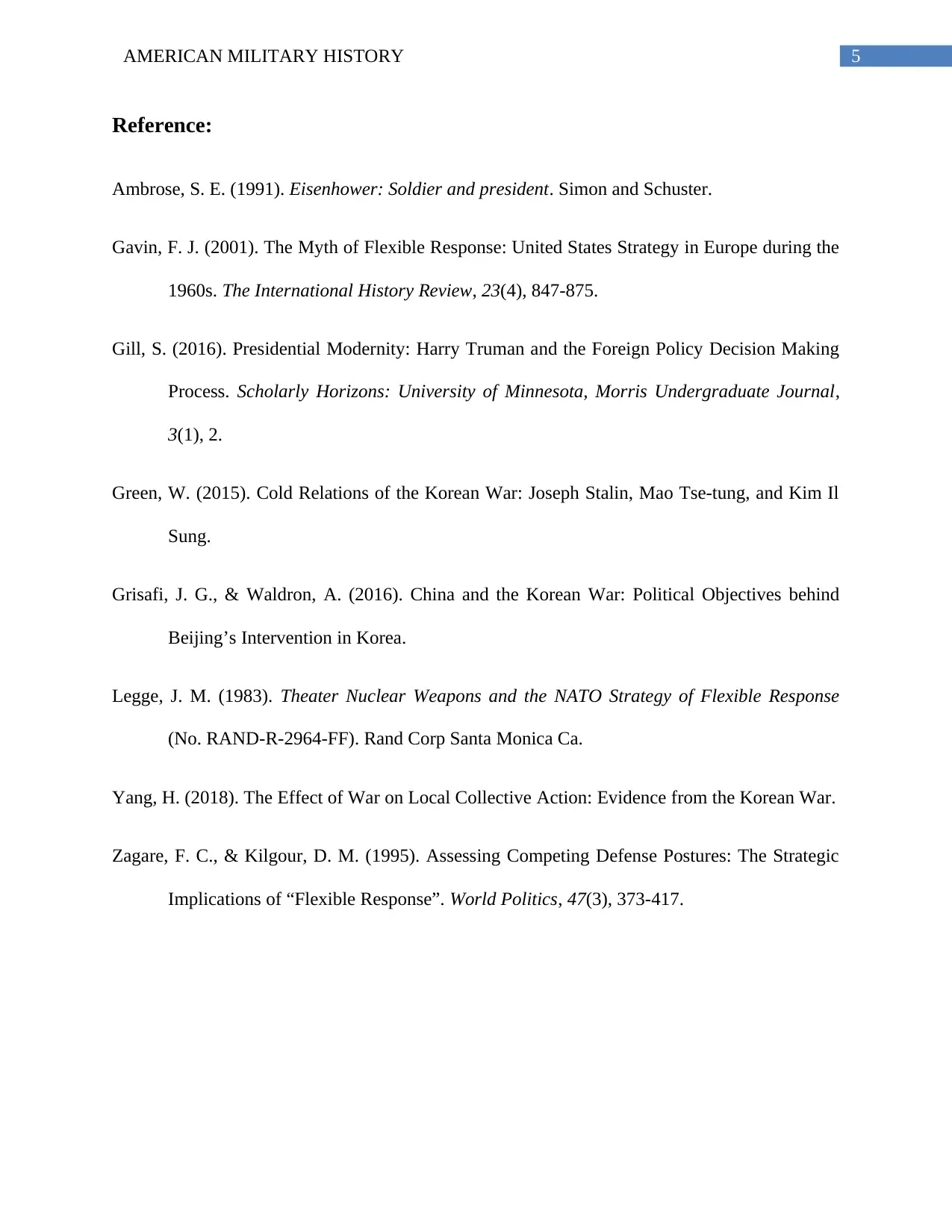
5AMERICAN MILITARY HISTORY
Reference:
Ambrose, S. E. (1991). Eisenhower: Soldier and president. Simon and Schuster.
Gavin, F. J. (2001). The Myth of Flexible Response: United States Strategy in Europe during the
1960s. The International History Review, 23(4), 847-875.
Gill, S. (2016). Presidential Modernity: Harry Truman and the Foreign Policy Decision Making
Process. Scholarly Horizons: University of Minnesota, Morris Undergraduate Journal,
3(1), 2.
Green, W. (2015). Cold Relations of the Korean War: Joseph Stalin, Mao Tse-tung, and Kim Il
Sung.
Grisafi, J. G., & Waldron, A. (2016). China and the Korean War: Political Objectives behind
Beijing’s Intervention in Korea.
Legge, J. M. (1983). Theater Nuclear Weapons and the NATO Strategy of Flexible Response
(No. RAND-R-2964-FF). Rand Corp Santa Monica Ca.
Yang, H. (2018). The Effect of War on Local Collective Action: Evidence from the Korean War.
Zagare, F. C., & Kilgour, D. M. (1995). Assessing Competing Defense Postures: The Strategic
Implications of “Flexible Response”. World Politics, 47(3), 373-417.
Reference:
Ambrose, S. E. (1991). Eisenhower: Soldier and president. Simon and Schuster.
Gavin, F. J. (2001). The Myth of Flexible Response: United States Strategy in Europe during the
1960s. The International History Review, 23(4), 847-875.
Gill, S. (2016). Presidential Modernity: Harry Truman and the Foreign Policy Decision Making
Process. Scholarly Horizons: University of Minnesota, Morris Undergraduate Journal,
3(1), 2.
Green, W. (2015). Cold Relations of the Korean War: Joseph Stalin, Mao Tse-tung, and Kim Il
Sung.
Grisafi, J. G., & Waldron, A. (2016). China and the Korean War: Political Objectives behind
Beijing’s Intervention in Korea.
Legge, J. M. (1983). Theater Nuclear Weapons and the NATO Strategy of Flexible Response
(No. RAND-R-2964-FF). Rand Corp Santa Monica Ca.
Yang, H. (2018). The Effect of War on Local Collective Action: Evidence from the Korean War.
Zagare, F. C., & Kilgour, D. M. (1995). Assessing Competing Defense Postures: The Strategic
Implications of “Flexible Response”. World Politics, 47(3), 373-417.
⊘ This is a preview!⊘
Do you want full access?
Subscribe today to unlock all pages.

Trusted by 1+ million students worldwide
1 out of 6
Related Documents
Your All-in-One AI-Powered Toolkit for Academic Success.
+13062052269
info@desklib.com
Available 24*7 on WhatsApp / Email
![[object Object]](/_next/static/media/star-bottom.7253800d.svg)
Unlock your academic potential
Copyright © 2020–2025 A2Z Services. All Rights Reserved. Developed and managed by ZUCOL.




